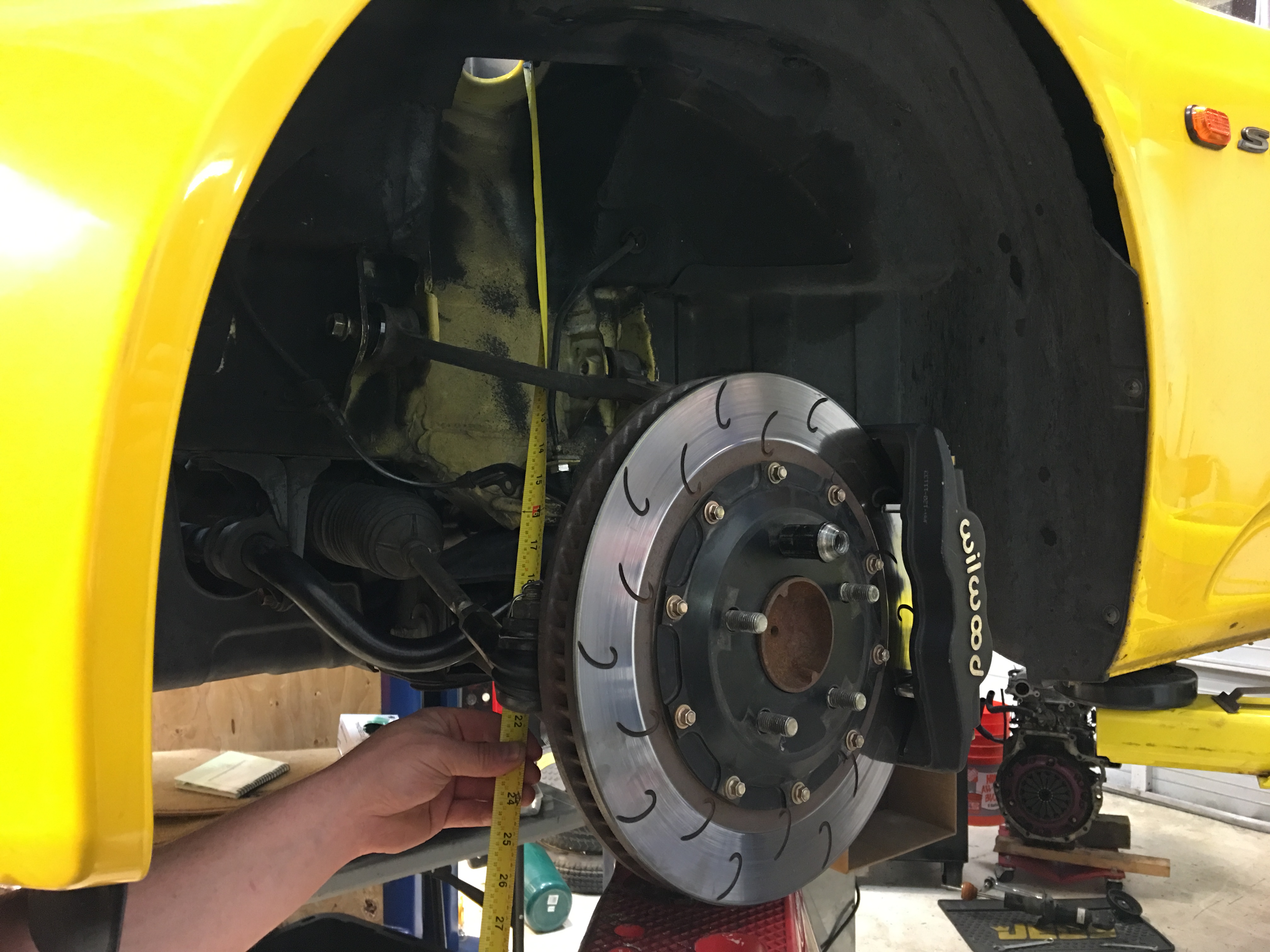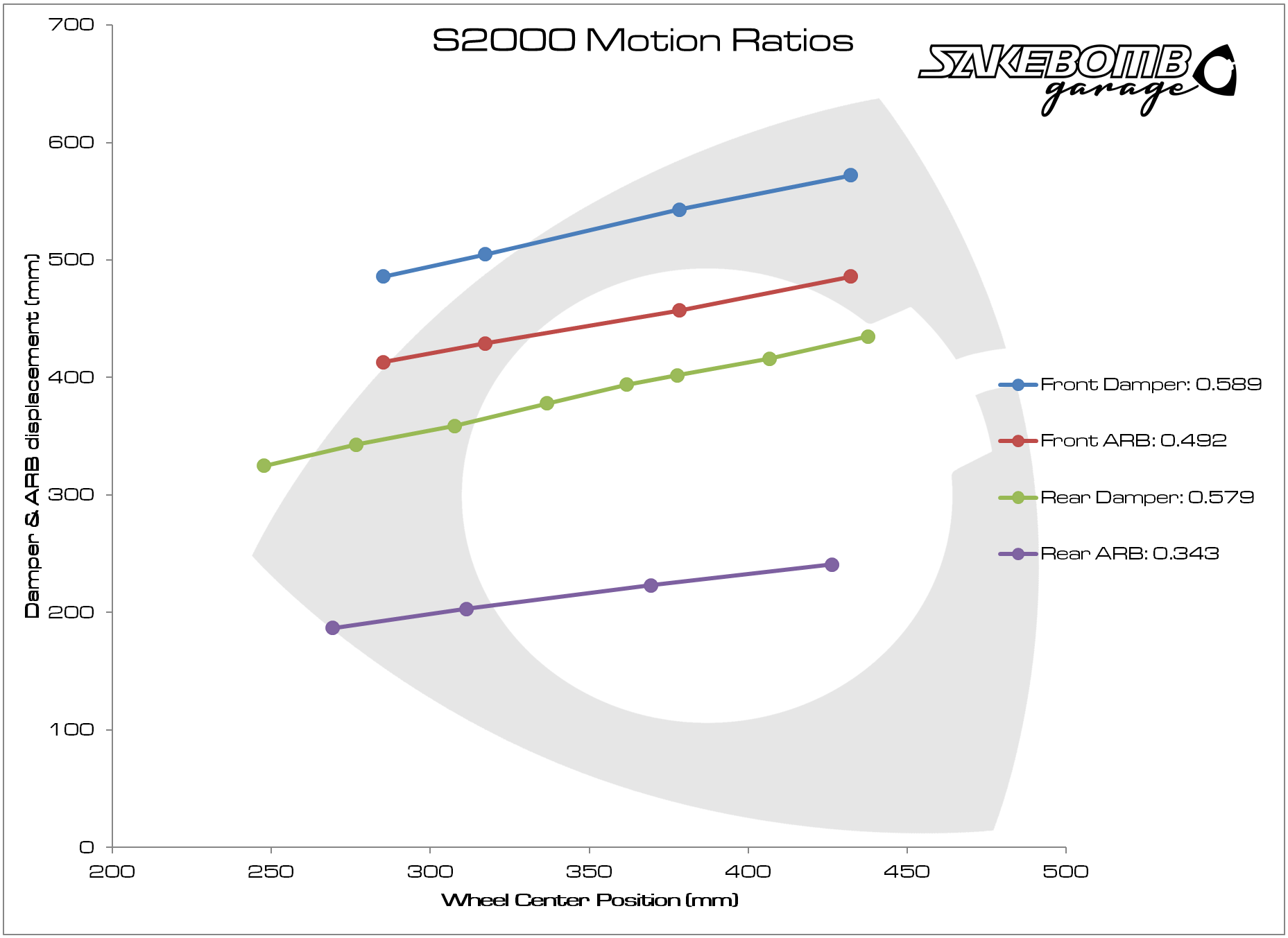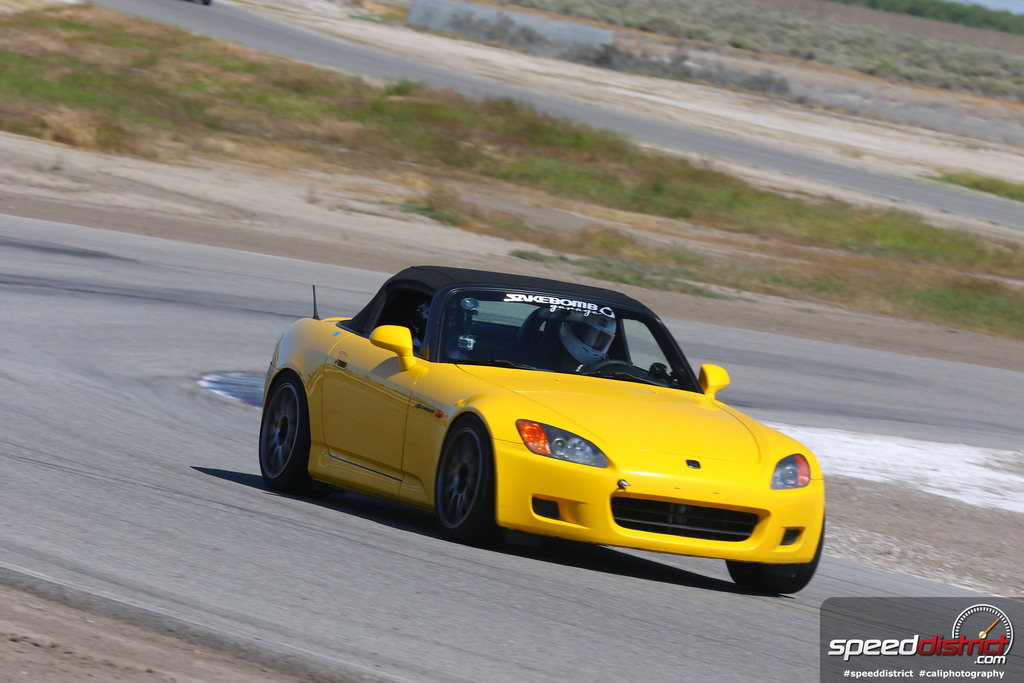The Actual S2000 Suspension Motion Ratios
#1

During recent developement we noticed a lot of disagreement within the community as to what the S2000 damper and anti-roll bar motion ratios are. A lot of people are calculating motion ratios using lever lengths of the lower control arm and damper angle correction values. This is easy way to get approximate values but clearly doesn't get very consistent results based on what we've seen.
-----------------------------------------------------------------------------------------------
Motion Ratio is defined as Damper Travel/Wheel Travel and to get more accurate results we went ahead and measured this directly.

While we were at it we also measured the anti-roll bar motion ratios are.

Damper motion ratios are: 0.589 Front and 0.578 Rear
ARB motion ratios are: 0.492 Front and 0.343 Rear
To be clear, these number do not need an angle correction factor, if you are using a calculator with an angle correction term it should be set to 1. As these are the true motion ratios they do not need to be corrected for spring angle.
Now that motion ratios are known, we can generate some wheel rate conversion factors:
Wheel rate = Spring Rate * MR^2
Front Wheel Rate = Front Spring Rate * 0.347
Rear Wheel Rate = Rear Spring Rate * 0.334
-----------------------------------------------------------------------------------------------
Some people find the MR^2 confusing, the reason the squared is there is because the MR is applied to both the force side of things and the travel side of things. This also means that the accuracy of the motion ratio very important as any error in the number is squared.
When vertical load is applied on the tire,
Damper Load = Wheel Load / MR
Then the damper deflects,
Damper Travel = Damper Load / Spring Rate
The the wheel travels due to the damper travel,
Wheel travel = Damper travel / MR
Wheel rate is the force per wheel travel,
Wheel Rate = Wheel Load / Wheel Travel
Wheel Rate = (Damper Load * MR) / (Damper Travel / MR)
Wheel Rate = Damper Load / Damper Travel * MR^2
Wheel Rate = Spring Rate * MR^2
-----------------------------------------------------------------------------------------------
Hopefully this will help with everyone's coilover setup. Feel free to reply here or send us a PM with any questions.
Stay tuned for more information and for some exciting upcoming product announcements!
-SBG

__________________
SAKEBOMB GARAGE > Click here to contact Us
Check some of our most popular products for the S2000:
- Ohlins DFV Billet Lower Mount
- Rear BBK RX-8 Caliper Conversion
- Front BBK AP Competition
- Setrab Oil Cooler Kit
SAKEBOMB GARAGE > Click here to contact Us
Check some of our most popular products for the S2000:
- Ohlins DFV Billet Lower Mount
- Rear BBK RX-8 Caliper Conversion
- Front BBK AP Competition
- Setrab Oil Cooler Kit
#5
Very interesting. Thanks for sharing this info with the community. I've thought about doing this before but it was such a hassle to pull apart my car that it wasn't worth it. I always felt like the posted numbers were off so I measured mine the conventional way, like a lever problem, and got lower numbers than the ones I've seen posted. They were still off from yours though. It's great to finally know what they actually are!
I must say I'm surprised how linear the wheel travel/shock travel is.
An interesting implication of this new MR data is that anyone who has calculated their ride frequencies with the old numbers has quite a bit lower Hz than they thought.
I must say I'm surprised how linear the wheel travel/shock travel is.
An interesting implication of this new MR data is that anyone who has calculated their ride frequencies with the old numbers has quite a bit lower Hz than they thought.
#6
Right, so based on this, is there really a necessity or any benefit to adjusting the roll center on a lowered S2000? I never bothered to do it, and am lowered 2". Toe correction kit seems to be the only benefit.
#7
Originally Posted by freetors' timestamp='1472868440' post='24054014
I must say I'm surprised how linear the wheel travel/shock travel is.
A linear springs' deflection is determined by how much force is applied and how stiff the spring is. Similarly, a torsional springs' deflection is determined by the moment applied and its stiffness. The springs and antiroll bars combine to provide the stiffness in roll, the roll center heights help determine amount of roll . So although it is very good to see that the motion ratios are consistent throughout the suspension travel, the roll center heights could also be changing which would effect consistency and performance.
One of our upcoming projects is to characterize the roll center heights and their migration on the s2000 and we will be sure to share the results and provide a more detailed explanation.
__________________
SAKEBOMB GARAGE > Click here to contact Us
Check some of our most popular products for the S2000:
- Ohlins DFV Billet Lower Mount
- Rear BBK RX-8 Caliper Conversion
- Front BBK AP Competition
- Setrab Oil Cooler Kit
SAKEBOMB GARAGE > Click here to contact Us
Check some of our most popular products for the S2000:
- Ohlins DFV Billet Lower Mount
- Rear BBK RX-8 Caliper Conversion
- Front BBK AP Competition
- Setrab Oil Cooler Kit
Trending Topics
#8
Originally Posted by s2000Junky' timestamp='1472882386' post='24054075
[quote name='freetors' timestamp='1472868440' post='24054014']
I must say I'm surprised how linear the wheel travel/shock travel is.
I must say I'm surprised how linear the wheel travel/shock travel is.
[/quote]
I look forward to that

#10
And for those who don't know about this sticky thread, here is some companion info regarding the OEM starting points, as researched by Twohoos.
Characterization of the OE Suspension Springs, Coil Springs and stabilizer bars
https://www.s2ki.com/...ension-springs/
Characterization of the OE Suspension Springs, Coil Springs and stabilizer bars
https://www.s2ki.com/...ension-springs/





